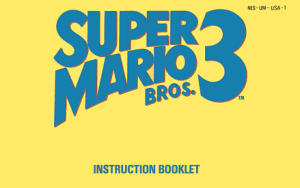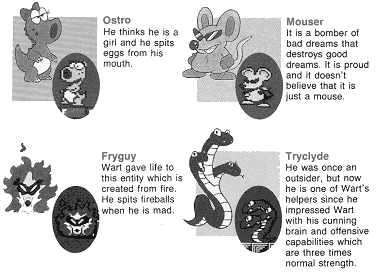I’ve got a confession to make — I’m one of the few people on the entire planet that actually reads the instruction manual before playing a new video game. Always have, always will.

The instruction booklet, seen here in its glory days.
Sure, knowing what the hell each power-up did was great, but for me, the reading of the instruction manual was always about the story and the characters. I wanted to know about the world I was about to enter, the monsters I was about to kill, the people I was about to play as, and their motivations for doing all of the insane stuff that developers would shove into their games.
It wasn’t enough to just play the game — I had to understand the mythology of the game, too (an affliction that still haunts me to this day, as I’ve spent many an hour looking up pointless things such as the chronology of the Metroid series, for example).
Perhaps it was the fact that the NES was a fairly simple console and therefore didn’t need pages upon pages explaining motion controls, alternate controls, memory and storage options, online settings, online troubleshooting, etc., but whoever was tasked with writing old-school instruction manuals had a lot of empty space to fill. Combined with the fact that most games never really told any sort of story during the actual gameplay (meaning that the writers could make up pretty much anything they wanted), you get a whole lot of crazy shit winding up in the hands of children across the world.
Take, for example, Super Mario Bros. According to the instruction booklet, the game’s plot goes a little something like this:
One day the kingdom of the peaceful mushroom people was invaded by the Koopa, a tribe of turtles famous for their black magic. The quiet, peace-loving Mushroom People were turned into mere stones, bricks and even field horsehair plants, and the Mushroom Kingdom fell into ruin.
The only one who can undo the magic spell on the Mushroom People and return them to their normal selves is the Princess Toadstool, the daughter of the Mushroom King. Unfortunately, she is presently in the hands of the great Koopa turtle king.
Mario, the hero of this story (maybe) hears about the Mushroom People’s plight and sets out on a quest to free the Mushroom Princess from the evil Koopa and restore the fallen kingdom of the Mushroom People.
You are Mario! It’s up to you to save the Mushroom People from the black magic of the Koopa!
Wait … what? Black magic? Only the Princess can reverse the spell? Mario is actually slaughtering the citizens of the Mushroom Kingdom with each brick he destroys? And all of this nonsense applies to a game where you run constantly to the right and eat mushrooms how, exactly?
To be fair, the very concept of the Mario series is so messed up that anything the writers could have concocted back then wouldn’t have made a whole lot of sense, really. At least they tried, and in doing so they produced a classic piece of video game literature.

The victim of black magic, apparently.
In my opinion, the best part about the instruction booklets for the NES Mario games were the detailed descriptions of the run-of-the-mill baddies Mario would encounter during his adventures. Without these ridiculous blurbs, I wouldn’t have terms such as Goomba, Lakitu, Spiny, Bullet Bill, Cheep-Cheep, Podoboo, Koopa Paratroopa, Beezo, Pokey, Sniffit, Trouter, Birdo, Monty Mole, Thwomp, and Ludwig von Koopa burned into my brain until the day I die.
And just like the main plot, the backstory for some of the baddies had to be fleshed out a bit (especially when their only characteristic was “walking left”), often with glorious results.

In the Mushroom Kingdom, walking slowly makes you a "wild fighter".
Unfortunately, classics instruction booklets a rare breed these days. Maybe Miyamoto and the boys assumed that we already knew what the hell a Goomba was (which is true), but the manuals for recent Mario titles such as New Super Mario Bros. and Super Mario Galaxy contain nary a single word about Mario’s enemies. These new manuals are sterile and soulless, featuring a rundown of the numerous control schemes and a brief explanation of the millions of power-ups found throughout the game — and nothing more.
And that’s a damn shame, because the colourful writing and sheer personality found in the older manuals was part of the unique Nintendo charm.

Admit it, you'd much rather read this insanity than learn how to troubleshoot your Nintendo Wi-Fi Connection.
Granted, at least Nintendo still puts in some semblance of effort with its newer Mario manuals. Lots of pictures and pretty colours, and all in all, they do a pretty good job of explaining the game mechanics. However, a lot of other game companies have completely done away with the in-depth manuals of old, replacing them with cheaply produced black-and-white inserts that explain practically next to nothing about any aspect of the game save for a tiny controller map outlining which button does what.
I suppose the justification is that since hardly anybody reads the manuals (besides me), there’s no point in devoting time and resources to the project. And while this makes sense, it hardly dampens the harsh blow of disappointment that festers inside me after skimming through yet another sub-par instruction booklet.
Luckily, the lost art of awesome instruction booklets isn’t completely lost, as a select few companies still “get it”.

Useful? Not really. A good read? Most definitely.
While the manuals for the Grand Theft Auto games will never be accused of being particularly useful (they’re more form than function), they’re always an entertaining read, as Rockstar Games presents the elements of the game through a series of well-written Liberty City phone books ads, tourism brochures, police bulletins, etc. It’s a truly great way to introduce the reader to the world they’re about to enter.
Meanwhile, Konami’s manual for Contra 4 for the Nintendo DS was hilariously old-school, written entirely in over-the-top, tongue-in-cheek, grammatically-incorrect language designed not to bore you with technical details, but to get you pumped about putting the boots to the alien menace. Even better, it also featured a list of enemies you’ll face along the way, including the ever-so-awesome “Ingrid Birdman” and “Missile Hugger 3000”.
While a few torchbearers of the craft remain, I fear for the future of the good ol’ instruction booklet, mostly due to the impending full-scale arrival of digital download delivery methods. Will the freedom of the digital form spark a renaissance for well-written and detailed manuals? Or is the instruction booklet as we know it witnessing its final days, soon to be replaced with mere FAQs and text files? Probably the latter … but I hope I’m wrong.
…
All video game manuals were sourced from ReplacementDocs.com. Check it out … it’s a great trip down memory lane, if I do say so myself!
Filed under: NES, Nintendo DS, Xbox 360 | Tagged: Contra, Grand Theft Auto, Instruction Booklets, Konami, Nintendo, Rockstar Games, Super Mario Bros. | 2 Comments »






